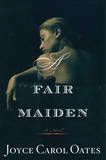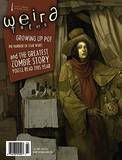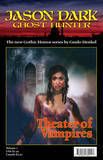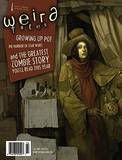Dweller / Jeff Strand
 Leisure Books / April 2010
Leisure Books / April 2010
Reviewed by: I.E. Lester
Dweller is one of the strangest coming-of-age tales featuring one of the most unusual friendships you’re likely to ever read, and one that could easily earn the tagline: The touching story of one boy and his monster.
In 1953, eight-year-old Toby Floren has his first meeting with a yeti-like humanoid creature in the woods near his house. He's initially terrified of it. But as he ages into a loner teenager he continues to encounter the creature — which is in as much need of a friend as Toby.
Toby and Owen (the newly christened monster) develop an unconventional friendship (to say the least), one that proves to be surprisingly enduring — even getting over the occasional "Oops, did I just eat your friends?" moment.
Although the tone of Dweller isn’t quite as flippant as this short synopsis might suggest, the book does struggle at times to find its identity. It’s a book the reader would like to fall into one camp or another – all-out gorefest or sensitive coming-of-age tale – but it ultimately fails to fully deliver on either. When Owen plays it nasty monster-style, it's all too brief and the ramifications of the violence feel inconsequential. On the flipside, Strand only flirts with the Harry and the Hendersons-style relationship between boy and monster so the story never fully develops into a comedic piece either.
But for its intermittent identity crisis, Dweller is not a book without virtue. Floren is a very well written character — the archetypal underachiever who excels in a menial job; a loner who escapes to play with his not-so-imaginary friend rather than make connections in the real world.
As with Strand's earlier Leisure novel Pressure, Dweller is told in episodes spread across decades. Each section highlights just enough to illustrate how the friendship between Toby and Owen evolves as one of near equals, rather than the boy and his pet dog equivalent that one might expect.
But Dweller is ultimately a sad story, and Strand takes full control of the reader's emotions. From the beginning, it's clear this is going to be a doomed friendship, and Strand makes you feel for both parties — even the human-eating monster. Toby and Owen are both desperately lonely souls, eager for companionship. There are some real emotional highs in Dweller — the initial moment of understanding when Toby feeds Owen and realizes he's not in danger of being eaten and their developing a sign language method of communication.
Although the reader is left with the feeling that Dweller could have soared to greater heights at times, there's a good deal to like within its pages. One thing is for certain: you’re not likely to read something quite like it again.
Purchase Dweller by Jeff Strand.
A Fair Maiden / Joyce Carol Oates
 Houghton Mifflin Harcourt / January 2010
Houghton Mifflin Harcourt / January 2010
Reviewed by: T.E. Lyons
This is a fable of generations, which clash so as to sort out their places with each other — and with the ages. Social classes play an important part, too. Inspiration, art, romantic love, familial obligation and lust fill out the burgeoning cast of themes that all have their say in this slender volume. And it wouldn’t truly be a gothic work if it didn’t have death standing by – not tallest, but most unwavering – to proclaim itself as the destination of all.
For avid fans of horror, A Fair Maiden might seem like an odd tangent. Professor Oates of Princeton – to most of her readers, the most unlikely of Stoker Award winners – is offering a short novel that can be seen as a character study of a troubled teenage girl from a small New Jersey town. The time is the present — but more importantly, it is one of those summers where everything changes for a teenage protagonist. Though this setting is indicative of mainstream fiction, the narrative structure by which the plot plays out has much of the classic gothic blueprint. The past will reach out from the grave to affect the girl’s future.
If she has any future, that is. For agents of the past are pulling at her, though in subtle ways. Oates’ very realistic setting of a semi-rootless summer-job situation demonstrates that the ties and opportunities of the present are very susceptible to seduction by the ever-romantic shadows of the past.
What’s brilliant about the portrayal of Katya – and why aspiring writers of dark fiction should consider seeking out this book – is that her thoughts and feelings come across with an even greater realism than her carefully drawn situation. While Oates likens Katya to the enigmatic title character of the traditional ballad “Barbara Allen,” the author puts the reader completely in touch with the convictions and impulses that are driving her modern-day protagonist. This is a 16-year-old pushed and pulled by demands that run beyond her age-appropriate emotional development. In defensive reaction to all of her external stresses, she makes decisions that pull her deeper into the web of an elderly man who wields charm and power. The girl turns away from him, multiple times, through a range of reasons as well as capricious whims — only to face other demands on her that show the old man to be as much an opportunity as he is a danger.
The ghosts of the past may be putting an unsuspecting protagonist into an unfamiliar and dangerous atmosphere, but usually such a classic gothic plot seems underdressed if there aren’t some scenes that pile on the sheer otherness. Even Austen did it (in Northanger Abbey). Oates will have just about none of that, apparently. It’s an everyday contemporary setting, and the otherness in this book is more a product of a teen’s fickle allegiances and nascent ambitions as it is the influence of the dead girls whose photos sit near the piano at the oceanfront mansion.
Oates also defies gothic conventions with some pacing tricks. She is gradual and deliberate (mostly slow, and intentionally unsteady) in how she introduces sex and death into the story. Strangest of all, the author announces that the ending will be abrupt, and makes good on her word. Too good, as far as this reader is concerned. After learning to enjoy gothic storytelling in which so many of the predictable comforts were subverted, it was painful but also a little disappointing when I had to close the cover just at the point that a body was growing cold.
Purchase A Fair Maiden by Joyce Carol Oates.
Depraved / Bryan Smith
 Leisure Books / September 2009
Leisure Books / September 2009
Reviewed by: I.E. Lester
The first thing you'll likely think when you start reading Bryan Smith’s Depraved is: "Hey, haven't I seen something like this before?" The answer is, yes, you have.
The action takes place in a remote American town called Hopkins Bend. The inhabitants of the town are degenerate almost beyond belief, and unfortunate visitors to Hopkins Bend find themselves in the midst of one of the most twisted bunch of inbreds and mutants who enjoy whiling away their time raping, torturing, killing and eating anyone who comes near them.
Sound familiar yet?
A few chapters in will call to mind any number of movies or books with similar plots: The Hills Have Eyes, Wrong Turn, Deliverance, and Jack Ketchum’s Off Season come immediately to mind. Even Friday the 13th and The Texas Chainsaw Massacre share similar plot elements.
But for the fact its plot hinges on a much-overused premise, there is a great deal to like about Depraved. For one thing, Smith has taken his mutant townsfolk to new depths of depravity. This is not an author who holds back. There is no sparing of the claret here, and the horror is not in the least bit sanitized. It's pretty sick stuff and contains a good amount of graphic violence — enough to satisfy the most hardened horror fan. Depraved is a downright brutal book, with its very last scene turning your stomach as much as its first.
Yet Smith somehow manages to avoid what could have been all too easy with this level of violence; namely, desensitization. Despite the nearly constant onslaught of viscera, the reader doesn’t become numb to the excesses of the book.
As for the characters themselves, Smith doesn't waste much time here on back story. His character-building is very concise, with just enough about each person revealed before being left to fill in the blanks yourself. Smith is on a mission in Depraved: He just wants to get to the mind-numbing violence without having to wade through a dozen pages about the next victim's grandmother. He also makes his good guys have to get down and dirty with the townsfolk, becoming nearly as twisted as them in their efforts to escape. They are not going to truly recover from this – ever.
Neither may the reader.
Depraved is not lightweight horror – and definitely not for the teen angst Twilight crowd. This is horror for the hardcore adult horror fan, with full-on gore, suspense, and sex – some of which will leave the reader squirming in their seat. If you can forgive him his re-use of a clichéd plot, Bryan Smith will not let you down.
Purchase Depraved by Bryan Smith.
“Ambient Morgue Music” / Richard Howard
 From Weird Tales #354 / Fall 2009
From Weird Tales #354 / Fall 2009
Reviewed by: Daniel R. Robichaud
"The best thing about being a reviewer is that you often receive music in the old fashioned way, via a CD through your letterbox." So begins Richard Howard's contribution to Weird Tales #354 (also available at the website).
In short time, readers are given the background of the entire story. The year is sometime in the 2030s, the reviewer in question operates out of Dublin, and the object of interest is the locally produced Ambient Morgue Music project, currently in its fourth volume. The music itself is a soundtrack for the end of the world: artfully rendered, lo fidelity, atmospheric music. Recently uncovering a contact number that works, the reviewer arranges to meet with the creative minds behind this intriguing project, and the story starts proper.
"Ambient Morgue Music" makes use of the unseen world trope from dark fantasy, here envisioning a society of the forgotten (reminiscent of Bentley Little's The Ignored) who make their home in Dublin's largest park. Not simply dispossessed, these people are trapped in this society, eking out a near-future-yet-primitive existence. Questions abound: who are these people, why they are here, and just what is this music that they are recording?
While the musical source – a revelation that lends macabre definition to the composition process – turns out to be less than surprising, a wealth of eeriness leading up to the anagnorisis rewards a reader's time investment. The presentation of the park and its inhabitants overflows with inventive, bizarre and unsettling ideas. Enough for a few more stories, possibly a novel.
"Ambient Morgue Music" reads like a review, which is interrupted by a vignette, which ultimately returns to a review. The quirky structure feels just authentic enough to have some folks searching the Internet for downloadable samples.
Purchase Weird Tales #354 with “Ambient Morgue Music” by Richard Howard.
Snow / Ronald Malfi
 Leisure Books / March 2010
Leisure Books / March 2010
Reviewed by: Joan Turner
The setting of the small, remote and seemingly deserted town and some of the early plot developments of Ronald Malfi’s new novel, Snow, may bring to mind the beginning of Stephen King’s Salem’s Lot — but do not be misled. The creatures here are not vampires, though just as deadly, and this completely original story holds more in common with Lovecraft’s cosmic horrors than King’s classic tale. Snow is a chill-a-minute thrill ride that will keep the reader spellbound until its astounding end. Ronald Malfi’s fast-paced plotting, smooth prose and strong, believable characters make Snow one of the best novels to bear the Leisure imprint in some time.
Four travelers stranded by a blinding winter snowstorm at Chicago’s O’Hare International Airport on Christmas Eve set out to drive across country to their holiday destinations. On a lonely stretch of road, they wreck their Jeep Cherokee attempting to avoid hitting a man in the middle of the road. The stranger claims his car has broken down and his eight-year-old daughter is lost in the snow, but when the travelers doubt his story, he flees into the woods where his daughter is waiting. With a damaged radiator, the travelers head for the nearest town, but soon discover the town is a death trap from which there seems no escape. Cut off from the outside and thrust into a struggle to survive against nightmarish entities, the travelers must use all their wit and courage to stay alive.
Ronald Malfi, author of Shamrock Alley, The Fall of Never, and Passenger, is a master of his craft. His descriptive ability and attention to detail bring credibility and immediacy to his character-driven stories. In Snow, Malfi’s pacing is near flawless, the suspense building to a stunning conclusion. Snow is an impressive work that leaves the reader eager to see more from this talented writer.
Purchase Snow by Ronald Malfi.
Jason Dark: Ghost Hunter / Guido Henkel
 Thunder Peak Publishing / March 2010
Thunder Peak Publishing / March 2010
Reviewed by: Michele Lee
"Your encounter with the extraordinary awaits," claims the tagline of the new Jason Dark: Ghost Hunter series by Guido Henkel. A sort of supernatural Sherlock Holmes, this serial series follows the adventures of Jason Dark, a Victorian London bachelor and Geisterjäger, who is the latest in a long line of ghost hunters.
The series has a feeling very similar to the Gabriel Knight series of video games from 1993, which is not surprising as Henkel is also a video game writer. Each serial is sixty-one pages, fast-paced and action-oriented, much like TV show episodes. Character building is also similar to that found in episodic TV, as each story is focused very tightly on the immediate plot and characters are primarily defined by their choices and actions rather than indicated by histories or reader knowledge of them. At times – particularly in the first book – this reads as somewhat flat, when compared to the more fleshed out forms of character and world-building found in full length novels.
In the first book, Demon's Night, Dark is introduced (again with a style that betrays very little, as if readers are already familiar with him — an aspect that may be off-putting to some) as he gets mixed up in a demon's plot to liberate its master from his prison, in this case an artifact which has recently come to London. Dark is soon joined by his to-be-permanent sidekick, Siu Lin, a Chinese immigrant (and kung fu mistress) whose parents are slaughtered by the demon. Together they must find the demon and stop it from feeding on Londoners to gain the power to unleash its master.
In book two, Theater of Vampires, Dark is invited to a theater performance by his old friend Max, and the show, predictably, is made up of vampires engaging in a very bloody performance before a live audience. The pace of the series really picks up with this book, as Dark and Lin both establish themselves as the sort of people who unquestioningly stand between the innocent (and unknowing) people and the forces of the supernatural who seek to prey on them. Also refreshing is Siu Lin as the fighter of the pair, a capable brawler and tactician in her own right, rather than a mere romantic interest or helpless sidekick.
In book three, Ghosts Templar, Dark and Lin take a field trip trying to find a missing Constable. Instead, they find a town besieged with a 500-year-old curse, where the burned bodies of a group of Templar Knights rise nightly to take their revenge on the decedents of the people who killed them. By this point, Lin and Dark are both rooted very firmly in their cause and their roles as protectors of mankind. Their knowledge now stems from research and deduction rather than sometimes feeling like it's coming out of nowhere.
There are some minor flaws to the overall story, like the questionable loyalty to historical fact (but this is a paranormal series, so there’s some flexibility here), repetitive descriptions, and the nature of the story length that contributes to this serial having a different feel than a full-length novel. The stories themselves, as well as the drama within, are also often familiar and predictable. That said, the tales are all satisfying reads, fleshed out and free of gaping narrative holes.
The Dark books would make fine bus stop or waiting room reads, especially for readers who really enjoy paranormal episodic television, such as Supernatural, Tru Calling, Medium and Ghost Whisperer. Or excellent reads for fans of old mystery series like the Hardy Boys, Nancy Drew or the Bobbsey Twins — particularly if you thought adding in a measure of the truly supernatural would have improved those series.
Purchase Jason Dark: Ghost Hunter by Guido Henkel:
“The Buzzard” / Eric Red
 From Weird Tales #354 / Fall 2009
From Weird Tales #354 / Fall 2009
Reviewed by: Daniel R. Robichaud
"The Buzzard," Eric Red's contribution to Weird Tales #354, is a dark western, which echoes the style of Elmore Leonard's short fiction ("3:10 to Yuma"), the moodiness of Cormac McCarthy novels (Outer Darkness), and the morality play structure of EC Comics (particularly Crime SuspenStories, the non-supernatural flipside to Tales From the Crypt).
The tale begins with a scene so familiar as to be cliché. A nameless cowboy turned gunslinger (two very different occupations) rides across the Arizona desert. He is wounded, suffering the particular pains of a gut shot. Overhead, a buzzard circles, waiting for its meal.
The cowboy flees across the desert, and the buzzard follows.
Inevitability is the mood of this atmospheric tale. This fatalism makes the series of coincidences heralding the expected twist ending somewhat more palatable.
Actual characters are lacking in this story. Other than the Remington Peacemaker, proper names are conspicuous in their absence. Identities are limited to occupation/function: the cowboy, the buzzard, the horse, the sweetheart, the rustlers, a doctor. These people and memories have no names and even less defining characteristics, suggesting the barren environment scours individuality, stripping its occupants to raw archetypes.
In a nice touch, Death is ever present in the text, evoked from the baking sun, a trod upon cow skull, the cowboy's empty pistol, dreamless sleep, and more. The titular beasty is an obvious stand in for the Reaper. Even after the plot takes an unexpected turn before its final twist, the cowboy's stakes are inescapable: Death waits, though its patience is limited.
To its credit, the story is not unrelenting in its grimness. The prose incorporates a macabre sense of humor. This is a tale, the magazine's story note advises us, "In which we gain a new perspective on interspecies relationships." Indeed it is that.
Purchase Weird Tales #354 with “The Buzzard” by Eric Red.




